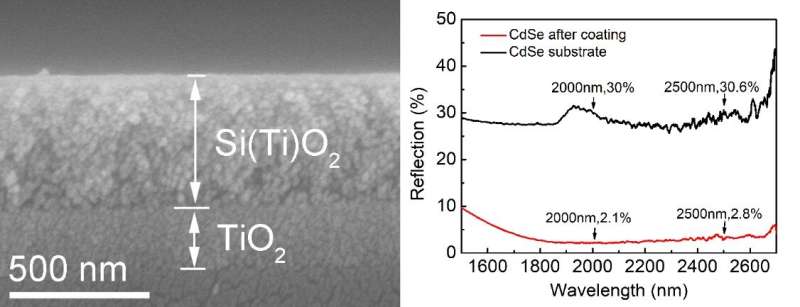Novel AR film developed to maximize the transmission of infrared light

High refractive index of the substrate material often leads to serious reflection on the surface of infrared optical elements, which will greatly reduce the transmittance of infrared light. To maximize the transmission of infrared light, antireflection (AR) film needs to be plated on the surface of infrared substrate. Sol-gel technology is an effective method for preparing high temperature resistant film. At present, there have been many reports on the preparation of AR film in visible light, however, it is still a challenge to prepare AR film working in infrared band by sol-gel method.
Recently, a research team from Hefei Institutes of Physical Science (HFIPS), Chinese Academy of Sciences (CAS) prepared the infrared antireflective films by sol-gel method basing on infrared substrate.
"What we made is two band double-layer infrared AR film coating on CdSe substrate." said Xu Shaohui, who is the first author of the paper, "Thick infrared film is usually not resistant to high temperature annealing, and we solved this problem by reasonably designing the sol composition and adding additives."
The pore size and particle size of the film is uniform and small, which effectively avoid the light scattering. After coating, the reflection can be reduced simultaneously at 2 μm and 2.5 μm, and the reflectivity is 2.1% and 2.8% respectively. At the same time, the film can reduce reflection in a wide band, the average reflectivity in 1.8-2.6 μm is 2.6%, which is 27% lower than that of the uncoated sample. The AR film remains intact after 10 cold and thermal shocks at high temperature of 400 °C and low temperature of -16 °C.
"It shows good high and low temperature resistance," said Xu.
This work is very important for further understanding the effects of additives and film structure on thermal stability. It provides valuable guidance for preparing long wavelength AR coating by sol-gel method, which is helpful to promote the development of infrared optical films.
Relevant research results were published on Colloids and Surfaces A: Physicochemical and Engineering Aspects.
More information: Shao Hui Xu et al, Preparation of double-layer two wavelength infrared antireflective coating on CdSe substrate, Colloids and Surfaces A: Physicochemical and Engineering Aspects (2021). DOI: 10.1016/j.colsurfa.2021.127329
Provided by Chinese Academy of Sciences





















